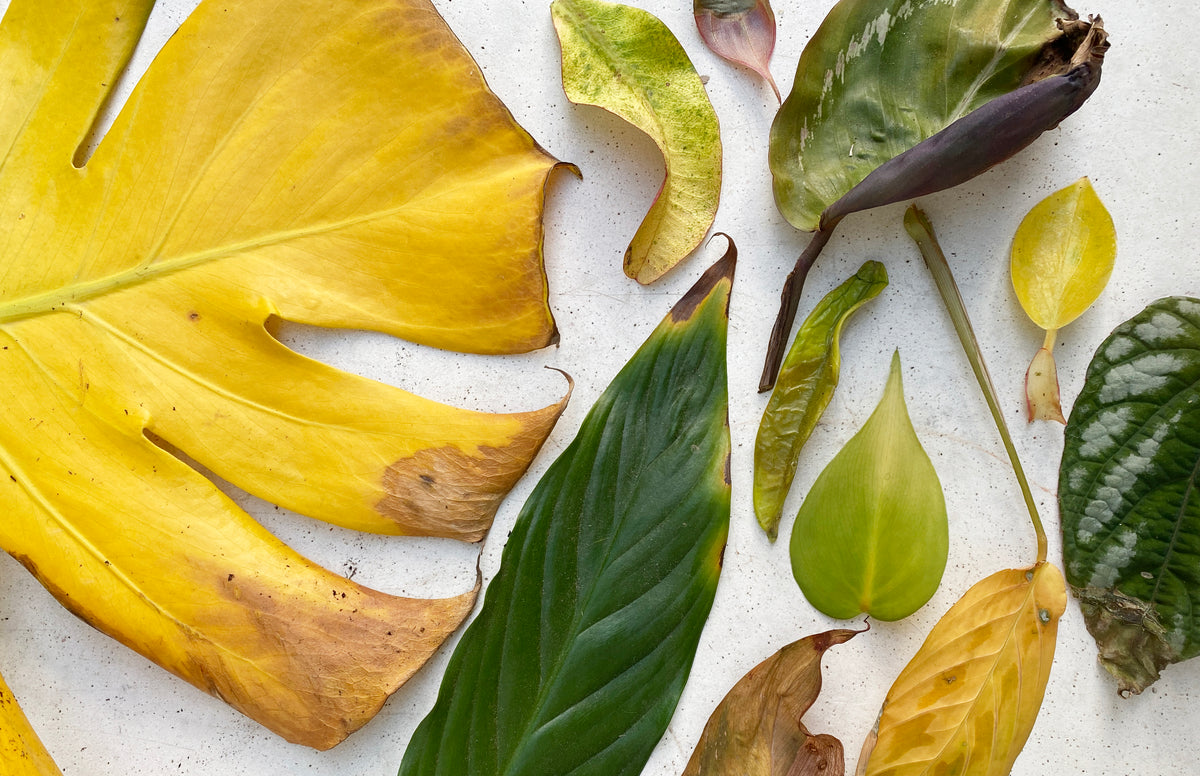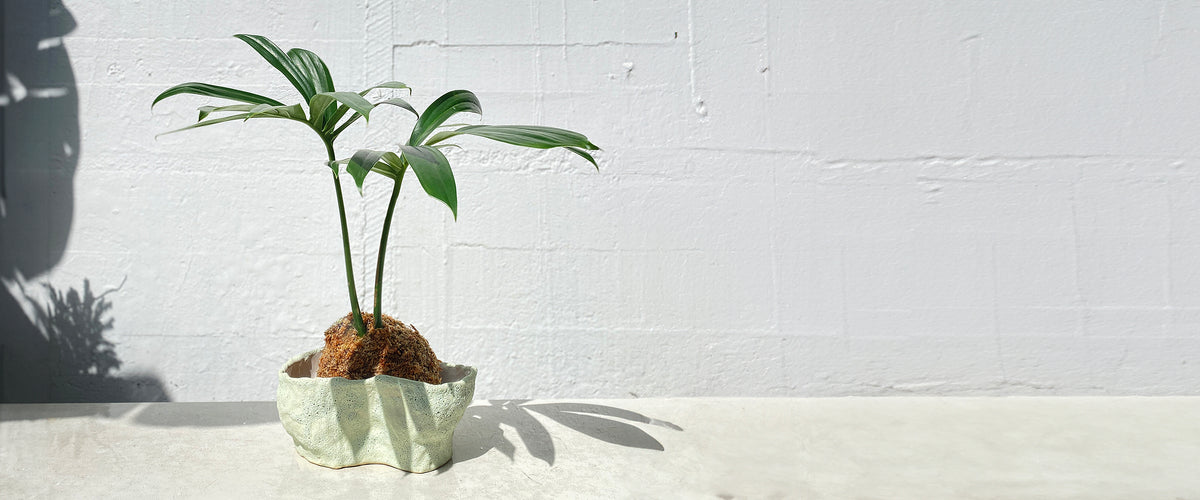Leafy Issues

We know becoming a plant parent often comes with some unprecedented problems- unhappy plants. You buy your beautiful new plant baby, looking lush and healthy, then arrive home and it throws a hissy fit. You had plans to become an indoor plant pro, and this kind of crushes your spirit. Don't worry, we can help, and nobody else has to know either!
Yellow Leaves

This one is a big one, because there's a lot of causes for it. It often makes people panic, but most of the time it's nothing to worry about! All plants naturally compost their oldest leaves, drawing the nutrients from the leaf into the root system. You can let the plant do this until the leaf drops off, or if you don't like how it looks you can snip it off, but be warned, you may be depriving your plant of much needed nutrients.
While the occasional yellow leaf is no reason for panic, yellowing leaves are a cause for concern when there are suddenly multiple yellow leaves on your plant. Unfortunately, this is often when you have to do some troubleshooting, as yellow leaves can happen for a few different reasons.
The most common is usually a watering issue. Underwatering or overwatering can mean your plant isn't able to take up it's usual dose of nutrients, causing the leaves to yellow as the plant tries to feed itself. Leaves going from yellow to mushy brown means overwatering, while yellow to crispy brown means underwatering.
Be sure to check for root rot too! Root rot will ruin your roots, leading to a sickly looking plant. Unpot and check your roots. If they're creamy white or yellow, you're safe. If they're brown and mushy, you have root rot. Cut any affected roots off and repot into different soil/propagate if you have no roots left.

An example of root rot showing through a plant's leaf
A word about watering: Make sure when you do water your plant, give it a good deluge! Water until it comes out the bottom of your pot. If you don't, the plant won't be evenly watered, and roots in dry patches can die off. If your pot doesn't have a drainage hole, make sure you put some scoria or pebbles at the bottom, and still water thoroughly, but less often as the water won't have anywhere to go.
Another cause for yellow leaves is light. Check that your plant isn't getting too much or too little light- just search your plant's name + "light conditions".
Your plant can also get yellow leaves from nutrient deficiency. If you wonder why your plants are so boring, never put out new leaves and are going yellow, don't get out the fertiliser just yet! It could be something else.
Your plant needs to stock up on much needed nutrients it would normally get from its natural habitat, whatever they might be. There are a few common deficiencies that could be affecting your plant.
Nitrogen deficiency starts with older leaves going yellow from the inside out.
Potassium deficiency causes your leaf edges to go yellow instead.
Magnesium deficiency is shown through mottled yellow leaves, coming from the centre outward.

Magnesium deficient leaf
If your plant's leaf is just going a steady yellow, go ahead and fertilise. Otherwise, get those other nutrients into your plant! Just make sure you're fertilising in Summer- unless your plants are special and actively grow all year round. Otherwise you'll end up with yellow leaves from too much fertiliser. Yes, we know- it's a fine line.

An example of what over-fertilising can look like- this can just be low humidity too, especially in peace lilies.
Crispy Leaves

This one can also be a couple different things. The most common is usually a lack of moisture. Most indoor plants are usually tropical, used to a high humidity environment, so being in a dry New Zealand house often is a bit of a shock! This is most common in plants like calatheas, ferns, and peace lilys. If you notice the edges of your plant have the texture of a pringles chip, first check where you have your plant. Is it next to a heater, air conditioner or fire? These expel a lot of hot, dry air, and will crisp up your plant in no time. Try moving it to a more neutral area. If this doesn't help, you can use a humidifier or a daily mist to boost your plant's humidity.
Another reason for crispy leaves is your water quality. Sometimes, tap water can cause salt, minerals, and fluoride to build up in the soil of your plant. If you know your tap water is particularly hard, try letting your tap water sit for a day to expel some of the chemicals, or use rain water when you can.
Finally, you may have given your plant sunburn! If the crispy leaves cut off at strange angles, or the leaves underneath have a yellow outline of the upper leaf, you definitely have your plant in too much sun! Cut the sunburnt leaves off and place in a shadier space, your plant will thank you.
See Through Spots
This one is not as common, and therefore harder to find advice on. Your plant has a see through, paper thin spot, and you are stumped. Google tells you nothing! Well, it could be for a few reasons. One of them could simply be you've put your plant in too bright of a spot. You may have put your plant too close to a glazed window, and the concentrated light may have given your plant an unsightly translucent patch. Just move your plant to a slightly darker area, and this should stop the patches. However, if it continues, it's time to consider other options. The wrong soil could be one. Your plant might be in the wrong soil for its preferred conditions. Google your plants preferred soil and check if it matches up, and if not, it's repotting time! Another reason may be nutrient deficiency. Check your leaves for any signs of deficiency and treat accordingly.
Floppy Leaves
This one could be an easy fix, just as easily as it could be a hard one. Most of the time, a plant with floppy/droopy leaves often just means its thirsty! A lot of plants can be pretty dramatic, with fittonia and polka dot plants, peace lily, pothos, and caladiums being the main contenders. These babies will flop over as if they've just been shot, and perk up within a few hours once you water them. The drama!
If your plant just isn't perking up after a water, it may be something more serious. You may be overwatering or underwatering your plant depending on its care, or it could be responding to a dramatic change in temperature. You may have done a repot and accidentally left it out in the cold or in full sun, which is a sure thing for some damage to your plant, whether it be a droopy plant or sun/frostburn. This can also happen when transporting a plant in your car. Bring it in as soon as you can and return it to it's home, leaving the soil alone- don't water if it doesn't need it, it will most likely lose some leaves and wont need as much water going forward.
Don't forget your roots, my friend!
Any of these problems could be solved by checking if your plant is rootbound! A plant will do all sorts of dramatic acts to let you know it needs to go up a pot size, so be sure to check your roots too.
We hope this was the answer to some of your plant woes, and you feel like a pro at solving those weird leaf issues. Remember, if all else fails, google is your best friend. Look up your plant's name coupled with it's care info, or the issue you're experiencing, and there will be plenty of curated info there too. Just be sure to check a couple of different sites so you know your info is consistent.
Happy planting!
